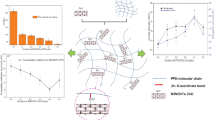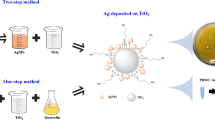Abstract
Sustainable composites derived from epoxidized natural rubber (ENR)/silver-substituted zeolite (AgZ)/poly(lactic acid) (PLA) blends possessing antibacterial activity were reported. ENR, herein, acted as an antibacterial promoter providing more hydrophilicity to the composites and facilitating water diffusion. Two methodologies were used to prepare composites, including solution casting (S) as well as solution casting followed by roll milling (SR). Both composites were compared in terms of morphology, AgZ dispersion, water absorption, and antibacterial activity. The shift of Tg and tan δ toward lower temperature of PLA composites consistently confirmed the compatibility between ENR and PLA by DSC and DMA results, respectively. The good AgZ distribution was observed in composites-SR, as confirmed by SEM/EDX. The results of agar disk diffusion susceptibility test showed that PLA, AgZ/PLA, and even ENR/AgZ/PLA composites-S showed no or less inhibition zone; meanwhile, ENR/AgZ/PLA composites-SR showed the significant inhibition zone against both Escherichia coli and Staphylococcus aureus. Besides, the antibacterial activity of the composites was required at least 5 wt% of AgZ. More than 98% inhibition of S. aureus growth by the composites-SR was observed during 2–24 h of cultivation, whereas AgZ/PLA provided the highest inhibition of only 75% at 24 h of cultivation. Hence, the incorporation of ENR enhances the bactericidal activity of the composites. In terms of mechanical properties, incorporating ENR into the composites decreased tensile modulus and strength, but increased the impact strength significantly. Therefore, the developed composites could be promising materials in food and biomedical fields in which antibacterial and impact resistance properties are required.













Similar content being viewed by others
References
Kenawy E-R, Worley SD, Broughton R (2007) The chemistry and applications of antimicrobial polymers: a state-of-the-art review. Biomacromol 8:1359–1384. https://doi.org/10.1021/bm061150q
Francolini I, Donelli G, Stoodley P (2003) Polymer designs to control biofilm growth on medical devices. Rev Environ Sci Biotechnol 2:307–319. https://doi.org/10.1023/b:Resb.0000040469.26208.83
Imazato S (2003) Antibacterial properties of resin composites and dentin bonding systems. Dent Mater 19:449–457. https://doi.org/10.1016/S0109-5641(02)00102-1
Markarian J (2009) Antimicrobials find new healthcare applications. Plastic Addit Compd 11:18–22. https://doi.org/10.1016/S1464-391X(09)70030-3
Appendini P, Hotchkiss JH (2002) Review of antimicrobial food packaging. Innov Food Sci Emerg Technol 3:113–126. https://doi.org/10.1016/S1466-8564(02)00012-7
Monteiro DR, Gorup LF, Takamiya AS, Ruvollo-Filho AC, Camargo E, Barbosa DB (2009) The growing importance of materials that prevent microbial adhesion: antimicrobial effect of medical devices containing silver. Int J Antimicrob Agents 34:103–110. https://doi.org/10.1016/j.ijantimicag.2009.01.017
Khare MD, Bukhari SS, Swann A, Spiers P, McLaren I, Myers J (2007) Reduction of catheter-related colonisation by the use of a silver zeolite-impregnated central vascular catheter in adult critical care. J Infect 54:146–150. https://doi.org/10.1016/j.jinf.2006.03.002
Inoue Y, Hoshino M, Takahashi H et al (2002) Bactericidal activity of Ag–zeolite mediated by reactive oxygen species under aerated conditions. J Inorg Biochem 92:37–42. https://doi.org/10.1016/S0162-0134(02)00489-0
Quintavalla S, Vicini L (2002) Antimicrobial food packaging in meat industry. Meat Sci 62:373–380. https://doi.org/10.1016/S0309-1740(02)00121-3
Loertzer H, Soukup J, Hamza A et al (2006) Use of catheters with the AgION antimicrobial system in kidney transplant recipients to reduce infection risk. Transplant Proc 38:707–710. https://doi.org/10.1016/j.transproceed.2006.01.064
Rusin P, Bright K, Gerba C (2003) Rapid reduction of Legionella pneumophila on stainless steel with zeolite coatings containing silver and zinc ions. Lett Appl Microbiol 36:69–72. https://doi.org/10.1046/j.1472-765X.2003.01265.x
Cowan MM, Abshire KZ, Houk SL, Evans SM (2003) Antimicrobial efficacy of a silver-zeolite matrix coating on stainless steel. J Ind Microbiol Biotechnol 30:102–106. https://doi.org/10.1007/s10295-002-0022-0
Galeano B, Korff E, Nicholson WL (2003) Inactivation of vegetative cells, but not spores, of Bacillus anthracis, B. cereus, and B. subtilis on stainless steel surfaces coated with an antimicrobial silver- and zinc-containing zeolite formulation. Appl Environ Microbiol 69:4329–4331
Casemiro LA, Martins CHG, Pires-de-Souza F, Panzeri H (2008) Antimicrobial and mechanical properties of acrylic resins with incorporated silver–zinc zeolite—part I. Gerodontology 25:187–194. https://doi.org/10.1111/j.1741-2358.2007.00198.x
Abe Y, Ishii M, Takeuchi M, Ueshige M, Tanaka S, Akagawa Y (2004) Effect of saliva on an antimicrobial tissue conditioner containing silver–zeolite. J Oral Rehabil 31:568–573. https://doi.org/10.1111/j.1365-2842.2004.01267.x
Hotta M, Nakajima H, Yamamoto K, Aono M (1998) Antibacterial temporary filling materials: the effect of adding various ratios of Ag–Zn–Zeolite. J Oral Rehabil 25:485–489. https://doi.org/10.1046/j.1365-2842.1998.00265.x
Yeo SY, Lee HJ, Jeong SH (2003) Preparation of nanocomposite fibers for permanent antibacterial effect. J Mater Sci 38:2143–2147. https://doi.org/10.1023/a:1023767828656
Silver S (2003) Bacterial silver resistance: molecular biology and uses and misuses of silver compounds. FEMS Microbiol Rev 27:341–353. https://doi.org/10.1016/S0168-6445(03)00047-0
Yoshida CMP, Bastos CEN, Franco TT (2010) Modeling of potassium sorbate diffusion through chitosan films. LWT Food Sci Technol 43:584–589. https://doi.org/10.1016/j.lwt.2009.10.005
Ouattara B, Simard RE, Piette G, Bégin A, Holley RA (2000) Diffusion of acetic and propionic acids from Chitosan-based antimicrobial packaging films. J Food Sci 65:768–773. https://doi.org/10.1111/j.1365-2621.2000.tb13584.x
Odani H, Uchikura M, Ogino Y, Kurata M (1983) Diffusion and solution of methanol vapor in poly(2-vinylpyridine)- block- polyisoprene and poly(2-vinylpyridine)-block-polystyrene. J Membr Sci 15:193–208. https://doi.org/10.1016/S0376-7388(00)80398-1
Ahmed J, Hiremath N, Jacob H (2017) Antimicrobial efficacies of essential oils/nanoparticles incorporated polylactide films against L. monocytogenes and S. typhimurium on contaminated cheese. Int J Food Prop 20:53–67. https://doi.org/10.1080/10942912.2015.1131165
Fernández A, Soriano E, Hernández-Muñoz P, Gavara R (2010) Migration of antimicrobial silver from composites of polylactide with silver zeolites. J Food Sci 75:E186–E193. https://doi.org/10.1111/j.1750-3841.2010.01549.x
Pongtanayut K, Thongpin C, Santawitee O (2013) The effect of rubber on morphology, thermal properties and mechanical properties of PLA/NR and PLA/ENR blends. Energy Procedia 34:888–897. https://doi.org/10.1016/j.egypro.2013.06.826
Zakaria Z, Islam MS, Hassan A et al (2013) Mechanical properties and morphological characterization of PLA/Chitosan/epoxidized natural rubber composites. Adv Mater Sci Eng. https://doi.org/10.1155/2013/629092
Wang Y, Chen K, Xu C, Chen Y (2015) Supertoughened biobased poly(lactic acid)–epoxidized natural rubber thermoplastic vulcanizates: fabrication, co-continuous phase structure, interfacial in situ compatibilization, and toughening mechanism. J Phys Chem B 119:12138–12146. https://doi.org/10.1021/acs.jpcb.5b06244
Jaratrotkamjorn R, Khaokong C, Tanrattanakul V (2012) Toughness enhancement of poly(lactic acid) by melt blending with natural rubber. J Appl Polym Sci 124:5027–5036. https://doi.org/10.1002/app.35617
Tham WL, Poh BT, Mohd Ishak ZA, Chow WS (2016) Epoxidized natural rubber toughened poly(lactic acid)/halloysite nanocomposites with high activation energy of water diffusion. J Appl Polym Sci. https://doi.org/10.1002/app.42850
Shameli K, Ahmad MB, Zargar M, Yunus WMZW, Ibrahim NA (2011) Fabrication of silver nanoparticles doped in the zeolite framework and antibacterial activity. Int J Nanomed 6:331–341. https://doi.org/10.2147/IJN.S16964
Phinyocheep P, Phetphaisit CW, Derouet D, Campistron I, Brosse JC (2005) Chemical degradation of epoxidized natural rubber using periodic acid: preparation of epoxidized liquid natural rubber. J Appl Polym Sci 95:6–15. https://doi.org/10.1002/app.20812
Bradbury JH, Perera MCS (1985) Epoxidation of natural rubber studied by nmr spectroscopy. J Appl Polym Sci 30:3347–3364. https://doi.org/10.1002/app.1985.070300817
Davey JE, Loadman MJR (1984) A chemical demonstration of the randomness of epoxidation of natural rubber. Brit Polym J 16:134–138. https://doi.org/10.1002/pi.4980160305
Burfield DR, Lim K-L, Law K-S, Ng S (1984) Analysis of epoxidized natural rubber. A comparative study of d.s.c., n.m.r., elemental analysis and direct titration methods. Polymer 25:995–998. https://doi.org/10.1016/0032-3861(84)90086-7
Kourki H, Famili MHN, Mortezaei M, Malekipirbazari M (2018) Mixing challenges for SiO2/polystyrene nanocomposites. J Thermoplast Compos 31:709–726. https://doi.org/10.1177/0892705717718599
Yuzay IE, Auras R, Selke S (2010) Poly(lactic acid) and zeolite composites prepared by melt processing: morphological and physical–mechanical properties. J Appl Polym Sci 115:2262–2270. https://doi.org/10.1002/app.31322
Wang H, Sun X, Seib P (2001) Strengthening blends of poly(lactic acid) and starch with methylenediphenyl diisocyanate. J Appl Polym Sci 82:1761–1767. https://doi.org/10.1002/app.2018
Shogren R (1997) Water vapor permeability of biodegradable polymers. J Environ Polym Degrad 5:91–95. https://doi.org/10.1007/bf02763592
Mat Uzir Wahit AH, Ibrahim AN, Zawawi NA, Kunasegeran K (2015) Mechanical, thremal, and chemical resistance of epoxidized natural rubber toughened polylactic acid blends. Sains Malays 44:1615–1623
Spriger G, Shen C (1976) Moisture absorption and desorption of composite materials. J Compos Mater 20:2–20
Kushwaha PK, Kumar R (2009) Studies on water absorption of bamboo-polyester composites: effect of silane treatment of mercerized bamboo. Polym Plast Technol Eng 49:45–52. https://doi.org/10.1080/03602550903283026
Pötschke P, Krause B, Buschhorn ST et al (2013) Improvement of carbon nanotube dispersion in thermoplastic composites using a three roll mill at elevated temperatures. Compos Sci Technol 74:78–84. https://doi.org/10.1016/j.compscitech.2012.10.010
Jo Y, Garcia CV, Ko S et al (2018) Characterization and antibacterial properties of nanosilver-applied polyethylene and polypropylene composite films for food packaging applications. Food Biosci 23:83–90. https://doi.org/10.1016/j.fbio.2018.03.008
Kim JS, Kuk E, Yu KN et al (2007) Antimicrobial effects of silver nanoparticles. Nanomedicine 3:95–101. https://doi.org/10.1016/j.nano.2006.12.001
Jokar M, Abdul Rahman R, Ibrahim NA, Abdullah LC, Tan CP (2012) Melt production and antimicrobial efficiency of low-density polyethylene (LDPE)-silver nanocomposite film. Food Bioprocess Tech 5:719–728. https://doi.org/10.1007/s11947-010-0329-1
Cho K-H, Park J-E, Osaka T, Park S-G (2005) The study of antimicrobial activity and preservative effects of nanosilver ingredient. Electrochim Acta 51:956–960. https://doi.org/10.1016/j.electacta.2005.04.071
Becaro AA, Puti FC, Correa DS, Paris EC, Marconcini JM, Ferreira MD (2015) Polyethylene films containing silver nanoparticles for applications in food packaging: characterization of physico-chemical and anti-microbial properties. J Nanosci Nanotechnol 15:2148–2156. https://doi.org/10.1166/jnn.2015.9721
Prapruddivongs C, Sombatsompop N (2012) Roles and evidence of wood flour as an antibacterial promoter for triclosan-filled poly(lactic acid). Compos B 43:2730–2737. https://doi.org/10.1016/j.compositesb.2012.04.032
Zhang C, Wang W, Huang Y et al (2013) Thermal, mechanical and rheological properties of polylactide toughened by expoxidized natural rubber. Mater Des 45:198–205. https://doi.org/10.1016/j.matdes.2012.09.024
Nematollahi M, Jalali-Arani A, Modarress H (2019) High-performance bio-based poly(lactic acid)/natural rubber/epoxidized natural rubber blends: effect of epoxidized natural rubber on microstructure, toughness and static and dynamic mechanical properties. Polym Int 68:439–446. https://doi.org/10.1002/pi.5727
Acknowledgements
Partial support from an ERASMUS + grant 2015-1-FR01-KA107-014841 between Mahidol University and Le Mans University is gratefully acknowledged. Teaching assistance scholarship of Faculty of Science, Mahidol University to M. Taranamai is very much appreciated.
Author information
Authors and Affiliations
Corresponding author
Ethics declarations
Conflicts of interest
The authors declare no conflicts of interest.
Additional information
Publisher's Note
Springer Nature remains neutral with regard to jurisdictional claims in published maps and institutional affiliations.
Rights and permissions
About this article
Cite this article
Taranamai, P., Phinyocheep, P., Panbangred, W. et al. Antibacterial activity of sustainable composites derived from epoxidized natural rubber/silver-substituted zeolite/poly(lactic acid) blends. J Mater Sci 54, 10389–10409 (2019). https://doi.org/10.1007/s10853-019-03599-1
Received:
Accepted:
Published:
Issue Date:
DOI: https://doi.org/10.1007/s10853-019-03599-1




